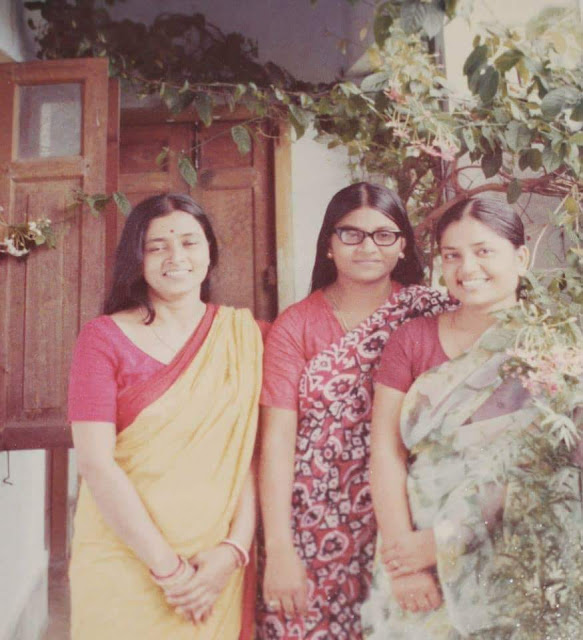Published in : Women Chapter
We were raised as Hindus. But when we were little, my
sister and I used to get new dresses, hand-stitched by my grandmother, on both the Eids
– Eid al-Fitr and Eid al-Adha. Eid al-Fitr means 'festival
of the breaking of the fast’ and it is celebrated at the end of Ramadan,
a month when many adult Muslims fast. Eid al-Adha - which means 'feast
of the sacrifice' - is celebrated just about three months later, at the same time
when many Muslims perform their holy Hajj pilgrimage to the Kaaba
Sharif. My friends and I celebrated with one another, our bright, new dresses blending into a crowd of color. Eid and Pujas were a time where Muslims and Hindus celebrated, dressed up in their very best.
My mom’s friend Joan auntie gave us two beautiful fragrant soaps from England.
In our childhood spent in Bangladesh, those were a treasure to cherish. So, we
stashed the soaps away for the whole year and only took them out on
special occasions. We used to take a few sniffs at those soaps, admire the
ornate plastic soap-box adorned with golden leaves; and on every Eid, very
early in the morning my sister Shyama and I used to take bath with those
fragrant soaps. Then, just when the Eid’s special prayer - the namaj - was done, we
used to go out to all my Muslim friends’ houses to have Eid’s special shemai- the sweet vermicelli pudding soaked with plump
raisins, almonds, and pistachios. I can still taste the special food to celebrate Eid - pulao, roast, korma, rejala, shami kabab,
and jorda made with saffron and orange slices on the tip of my tongue. Some fragrances never fade!
Growing up, I went many places with my Muslim friends. I went to Arabic
classes with them, as I was always ever inquisitive. I memorized the verses ayat of Surah
Ar-Rahman, 'fabi ayyi alai rabbikuma tukazziban' and Tasbi E Yunus , ‘la
ilaha illa anta subhanaka inni kuntu minaz zalimeen.’ I learnt to read the cursive
Arabic alphabets written from
right to left, ‘alif, beh, teh, theh, jim…’ I took comfort as a five-year-old
little girl that all my languages started with similar sounding alphabets. ‘A’ for
English, ‘O’ for Bengali, and ‘Alif’ for Arabic. Life is a calligraphy.
My grandfather's Muslim friends used to often visit our house. My grandfather always had a ‘jaynamaj’ – the prayer
mat- for his Muslim friends. I remember him telling us, ‘This is the best buy
of my life.’ Practicing Muslims pray five times a day. Ajan from the
mosques call them for their prayer – the namaj. My grandfather’s colleagues
were not atheists and agnostics like us. So, when they used to visit us, after hearing the maghrib’s ajan around 6:30 pm in the afternoon, we used to set up the ‘jaynamaj’ – the prayer mat – facing West, where Muslim’s holy shrine the Kaaba Sharif of Mecca is.
My family tried to respect the traditions of our Muslim friends, and they did the same. Non-vegetarian Hindus do not eat beef as they worship the holy cow. Muslims
sacrifice cows and goats for the Kurbani Eid- the Eid al-Adha. Then
they share that meat with their friends, neighbors, and the less fortunate. While
growing up, all my Muslim friends always used to send the kurbani meat to
our house – their Hindu neighbor. But nobody ever sent beef to our house, even
by mistake. Whenever we were invited to my Muslim friend’s houses for any kind
of party, they always used separate pots and spatulas to cook beef,
and goat-meat. Sometimes, I feel as if ‘touch’ is the underlying word in
any religion – touching meat, touching hearts, or out of touch.
I spent all my childhood years this way, amongst my
beloved Muslim friends. So, today when I hear the words religion, antireligion,
communalism, sectarianism, I really cannot write anything; to me they are all the pieces of a complex jigsaw puzzle. All these memories keep playing in front of me like reels of a motion picture film. My eyes become misty; my writing quill
just sits there untouched; I cannot dip it into ink. Is life a calligraphy?
 |
| This is one of our Eid dresses which my grandmother stitched. Yes, we were perennially and dreadfully shaved, as my aunt believed we would grow lustrous hair that way. |













Amazing flavour of life at our times ❤
ReplyDelete